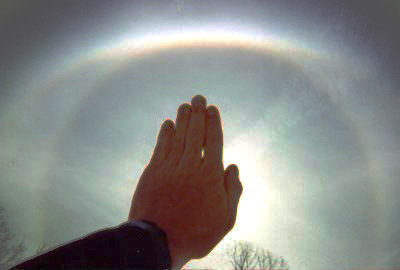
| |
Circumscribed
and 22� halos taken with a
disposable camera by Jeff Griffith in Garrett
County, Maryland. Expensive equipment is
not essential for good halo records. �Jeff
Griffith |
|
Halos are unpredictable, a once in a lifetime display might occur
at any time. Look up at the skies often. Be ready. Have
a lightweight digital or compact 35mm film camera always
close to hand.
Keep it simple. Complicated controls and interchangeable
lenses often mean that the best parts of a halo display are missed
while the camera is being readied. Make sure the camera always has batteries
and film/memory. When that rare halo display appears there will
be no time to change them.
As well as an 'always with you' compact camera, a high resolution
digital camera with optical zoom or a single lens reflex film camera
with good interchangeable lenses is very desirable for displays
seen from home. Keep a 24 or 28 mm lens in place on the SLR - quite
often there is just not time to change lenses.
Never look at the sun through the viewfinder
of an SLR and take extreme care with any camera. Safer and better
images are made with the sun shielded behind a pole or the edge
of a building.
If the display is too large for the field of view, take a series
of overlapping images. Images from a 50 mm lens will overlay better
in a montage than those from wide angle lenses. When a zoom lens
is used, stick to just one or at most two zoom settings. Photographs
at a variety of unspecified magnifications are difficult to overlay
or compare.
Pre-lock the focus to infinity ~ auto focus cameras have difficulty
focusing on halos. Exposures for solar halos will be short and film
cameras can use slow, 100 ISO, fine grained, high exposure latitude
film. Bracket the exposure two stops either way. Try to shield the
sun and the nearby very bright sky.
Labs with automatic printers often make a poor job of halo images.
For valuable images, get the negatives scanned onto CDROM before
they are covered with dust and scratches.
Digital
cameras give much better personal control over image processing.
Always archive the original digital image files before any
further processing or enhancement. The original image also contains
valuable EXIF data on the exposure, lens focal length and the time
the image was taken. Make a TIFF copy and use that for further processing.
Avoid multiple JPEG compression because this degrades images and
introduces artefacts. Keep the camera clock time accurate!
For more comprehensive advice try two expert halo photographers,
Harald
Edens and Mark
Vornhusen.
In summary... Always carry a camera. Keep things
simple. Take care of your eyes. Look
up often and have success photographing halos! |
